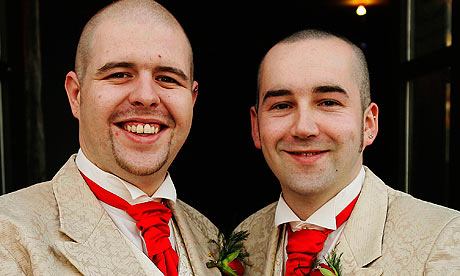Figures from Office of National Statistics much lower than the most commonly used estimate of 5% to 7%
• Datablog: get the full data behind the ONS sexual identity survey
• Datablog: get the full data behind the ONS sexual identity survey
- guardian.co.uk, Thursday 23 September 2010 14.07 BST
- Article history

Henry Kane (r) and Christopher Flanagan celebrate their civil partnership. The ONS figures found that over 45% of the gay community was cohabiting. Photograph: Peter Macdiarmid/Getty Images
Nearly three-quarters of a million adults in Britain say they are gay or bisexual, according to figures published for the first time today by the Office of National Statistics.
The findings, based on interviews with more than 450,000 people – the biggest pool of social data after the census – show that an estimated 481,000 people regard themselves as gay and a further 245,000 – mainly women – say they are bisexual.
The estimate puts Britain's gay community at 1.5% of the total population – much lower than the most commonly used estimate of 5% to 7%, which was cited by ministers introducing civil partnership legislation and implied a non-heterosexual population of 3.5 million.
The ONS said the higher estimate was based on different sampling methods and responses to questions about sexual attraction and behaviour both in the past and present.
The latest detailed figures show that gay people are much more likely to be in managerial or professional occupations – 49% compared with 30% for straight workers - and better educated, with 38% holding a degree. Their age profile is also much younger than the rest of the population, with 66% under the age of 44 and 17% aged 16 to 24.
Just over 45% of the gay community are cohabiting, although only 8% live in a household with at least one child present. A third of bisexual households include at least one child.
London is home to the highest concentration of gay people at 2.2% of the population, while this proportion falls to 0.9% in Northern Ireland.
The ONS said it was confident its survey had produced an accurate estimate based on a question of self-perceived sexual identity. Respondents were provided with a showcard containing four options: heterosexual/straight, gay/lesbian, bisexual or other. They were asked which option best described themselves.
Privacy from other household members was preserved by asking them to say "stop" when their option was reached. The ONS said a valid response was provided by 96% of those surveyed, with fewer than 4% refusing to respond to the question. The statisticians said this group could not be assumed to be secretly gay.
The results of the first Integrated Household Survey also showed that 71% of people in the UK say they are Christian, 4% are Muslim and 21% have no religious affiliation.
The statistics on religion – the first since the 2001 census – appeared to challenge the pope's assertion last week that Britain had become a country marked by an "aggressive secularism".
The data on religious affiliation showed that Slough had the highest concentration of religious devotion in England at 93%. Brighton had the lowest at 58%.
The findings, based on interviews with more than 450,000 people – the biggest pool of social data after the census – show that an estimated 481,000 people regard themselves as gay and a further 245,000 – mainly women – say they are bisexual.
The estimate puts Britain's gay community at 1.5% of the total population – much lower than the most commonly used estimate of 5% to 7%, which was cited by ministers introducing civil partnership legislation and implied a non-heterosexual population of 3.5 million.
The ONS said the higher estimate was based on different sampling methods and responses to questions about sexual attraction and behaviour both in the past and present.
The latest detailed figures show that gay people are much more likely to be in managerial or professional occupations – 49% compared with 30% for straight workers - and better educated, with 38% holding a degree. Their age profile is also much younger than the rest of the population, with 66% under the age of 44 and 17% aged 16 to 24.
Just over 45% of the gay community are cohabiting, although only 8% live in a household with at least one child present. A third of bisexual households include at least one child.
London is home to the highest concentration of gay people at 2.2% of the population, while this proportion falls to 0.9% in Northern Ireland.
The ONS said it was confident its survey had produced an accurate estimate based on a question of self-perceived sexual identity. Respondents were provided with a showcard containing four options: heterosexual/straight, gay/lesbian, bisexual or other. They were asked which option best described themselves.
Privacy from other household members was preserved by asking them to say "stop" when their option was reached. The ONS said a valid response was provided by 96% of those surveyed, with fewer than 4% refusing to respond to the question. The statisticians said this group could not be assumed to be secretly gay.
The results of the first Integrated Household Survey also showed that 71% of people in the UK say they are Christian, 4% are Muslim and 21% have no religious affiliation.
The statistics on religion – the first since the 2001 census – appeared to challenge the pope's assertion last week that Britain had become a country marked by an "aggressive secularism".
The data on religious affiliation showed that Slough had the highest concentration of religious devotion in England at 93%. Brighton had the lowest at 58%.
Everyone loves it when people come together and share ideas.
ReplyDeleteGreat blog, stick with it!
my homepage :: african mango plus
My website > african mango australia